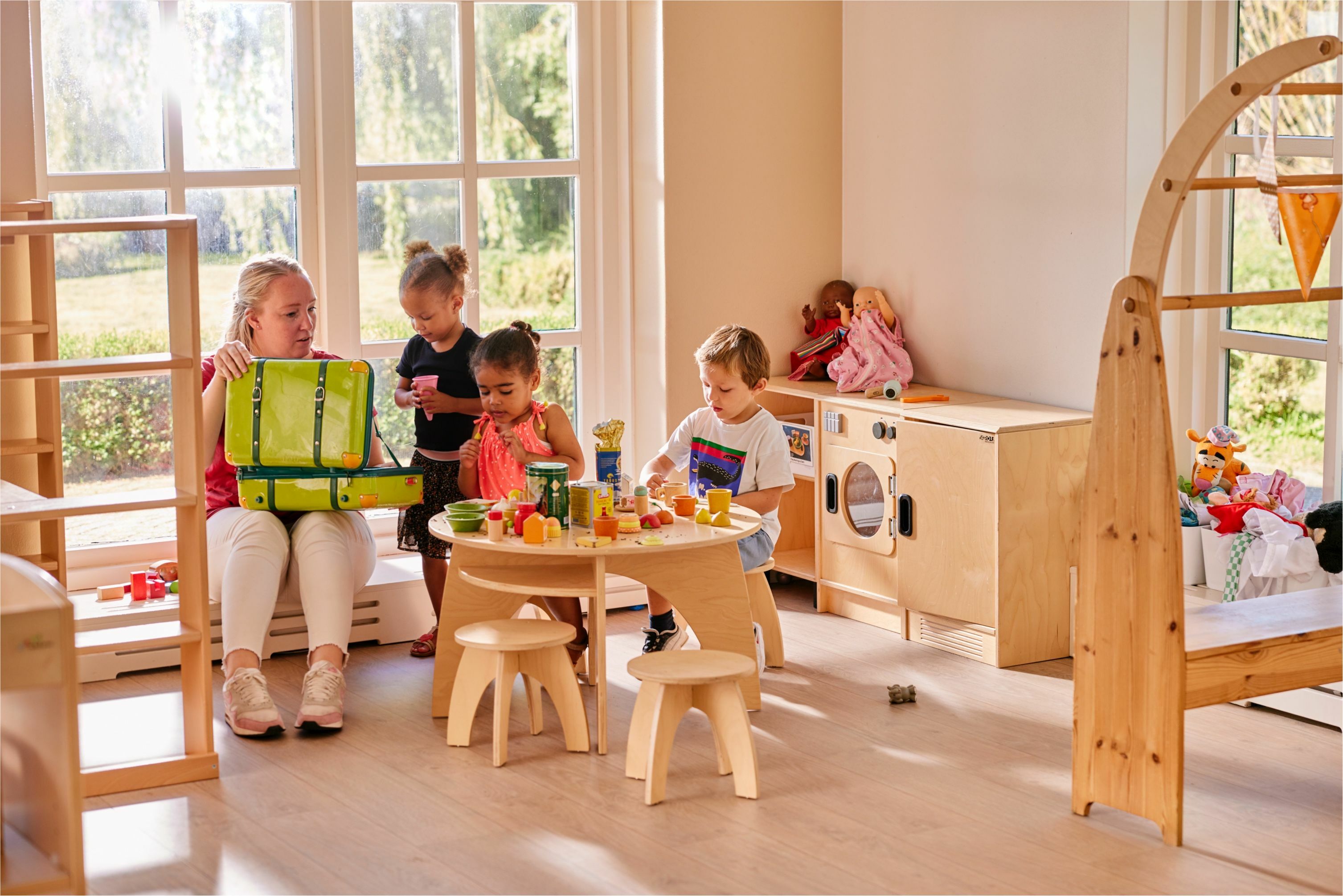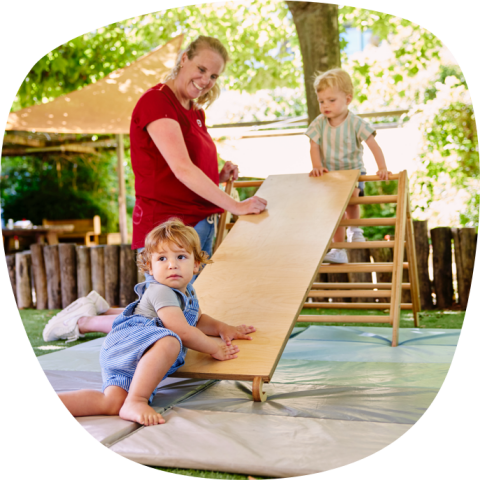
Movement corner
Climbing and clambering corner
Baby corner (day care)
Sport & Exercise

Cooking studio (out-of-school-care)
Outdoor kitchen
Outdoor space
Green & Healthy

Discovery corner
World corner
Construction corner
Media corner (out-of-school-care)
Technology corner (out-of-school-care)
Wise & Discover

Examples of play areas per building block
Games corner
Reading corner
World corner
Chill corner (out-of-school care).
Together & Play

Home corner
Shopping corner
Dressing up corner
Sensory corner (day care)
Chill corner (out-of-school-care)
Music corner
Theatre corner
Stage & Expression

Construction corner
creative corner
Studio with exhibition space (out-of-school-care)
Fantasy & Creation

Sensorimotor or theme table
'Open-ended material' often fits well with the various VE themes. There is often a theme table, also known as a sensorimotor table, at the VE locations. You will also find this table at our regular locations. Open-ended material or loose parts fit well with this. Think of plants, water, sand, shells, feathers, stones or autumn materials.
Themes
In the circle
At locations with preschool education (VE) things are slightly different than at regular locations. The design and layout at VE locations is in line with the idea that the environment for children should be as language-rich as possible. That is why the play areas and the bins with play material are often labelled. There often is a theme table and word cards are hung up on different places. The play areas are sometimes more in line with the themes from the VE programmes than with the six building blocks we use. Sometimes the municipality can impose certain conditions on the design of a group.
Play materials on VE groups are in line with the VE programs and the VE theme of the moment. When working with themes, it is best for children if they can play with matching material. We do this by, for example, setting up a theme corner or adding theme materials to the existing corners.
At a toddler care or VE group, we often use the free space for circle time. Daily rhythm cards are sometimes part of the VE program. They hang at table height, clearly visible for the children. It is a dedicated play-learning environment.
At preschool
We keep walking routes clear
There is always enough room to move between all the different places: the walking routes. Play areas where children play on the floor a lot, such as a building corner or a quiet corner, are never situated right next to a walking route. A table however can be situated in the middle of a walking route: that is a visible piece of furniture that you can easily walk around. Of course, we always keep escape routes and emergency exits clear.
At the out-of-school care
For out-of-school care facilities with multiple rooms, we always provide one homely space. This is a place that feels safe for the younger children and where a staff member is usually present. We prefer to design this space with play areas for the youngest. A nice place for them to play and relax after a busy school day. There is also a separate room for the older children. The children can think along about how we divide and structure this space. If it fits, there is a studio, theatre or music room.
Baby corner
Do we have babies in the group? Then we create a baby corner, a place for babies that is low in stimulus and noise. We do this both indoors and outdoors, as far away from a walking route or door as possible. We also pay attention to lighting or bright sun.
Free play area
In addition to fixed play areas, there is always free space in the group. Temporary playgrounds are created there on the initiative of the children. To encourage this, we lay down a blanket and some play material, for example. Cushions or dots on the floor are very suitable for creating a circle. At out-of-school care, children often shape the free play area themselves.
Outside the group
If there is no sufficient room in the group for all the play areas, then one or more areas can also be situated somewhere else in the building, such as in the hall, in a studio or in our outdoor area. Different groups can then make use of it.
The group structure and the use of play materials help us to create an enriching and varied playing environment. Our rooms are therefore divided into different play areas, which also include play material.
Variation in play
Each group has at least four play areas that children can access directly. As a result, there is a wide variety of play options. The choices we make depend on the possibilities the available space offers and the age structure of the group.
On your own, just for a moment
If possible, we bound the play areas with a rug on the floor, a low cupboard or partition wall. This gives children clarity and a sense of security and privacy. In this way, we also ensure that active and quiet play do not get mixed up too much. For older out-of-school care children, it is nice if a play area is a bit more private. They appreciate some extra privacy.
Logical play areas
Play areas are located in a logical place in the room: the table is close to the cupboard and a craft area is close to a tap.
Choose where you want to play
Play areas - we sometimes call them corners - invite children to choose where they are going to play, what they are going to do and with whom. As a result, they play more actively, there is more variety in their game and they play together more.
Different play areas
Sitting down at the table together
Eating, drinking or crafting together. It is fun and stimulates the group feeling. This makes the table in the group a central and important place.
Our rooms are well-kept and exude tranquillity. They invite children to play and discover together. We would like it to feel a bit like home. That is why the table in the house corner is nicely set. And the chill corner with cushions at the out-of-school care looks so good that you immediately want to flop into it.
A fixed place
Each child has a personal place for his or her belongings. A small box, basket or drawer with the name or photo of the child on it. For out-of-school care children, there is also a fixed place for their coat and bag, such as their own coat hook.
Something for everyone
We have an eye for differences between children. There are toys in different levels of difficulty, such as puzzles that differ in size and shape. Children choose what they would like to play with themselves.
Everyone is welcome
Photos of adventures in the group, photos that you have brought from home or an exhibition with the children’s creations reinforce that familiar feeling. Our game material radiates that everyone is welcome. Regardless of your background. For example, we have dress-up clothes from different cultures, books about various (family) situations and dolls with all kinds of skin colours. This way there is something familiar for everyone.
A familiar feeling
Safe and durable
Real material
Closed and open-ended material
Not too much and not too little
We also share some materials with the other groups. Such as musical instruments, a puppet theatre, a large train track or a sand and water table. Because children do not see these materials every day, they remain extra special.
Materials are used intensively at child care. That is why it is important that it lasts a long time and is safe. Where possible, we choose materials with a natural and sustainable look, such as wood with an FSC quality mark or sustainable (bio-) plastic. When purchasing toys, we make sure that they always have a CE mark and that they are suitable for the age of the children in the group. We take this into account when selecting our suppliers. Electric toys (battery-powered) are less beneficial for the environment. That's why we use them as little as possible. For safety's sake, we make sure that there are no button cell batteries or small, loose magnets in toys, in any case for the day care. These can be swallowed by children, which is dangerous. We follow the guidelines and advice on the website of the Dutch Institute for Consumer Safety www.veiligheid.nl.
A toy car, Playmobil or a doll: these are all play materials with a clear function and manufactured to be toys. But children also really like to give a function to material themselves. We think it is important that play material challenges children to fantasize and discover for themselves. A tree trunk can be a crocodile, train, or diving board. An empty box becomes a hut or a branch becomes a magic wand. So-called 'open-ended materials' or loose parts do not have fixed rules. Kids love it!
Children love to play with 'material for grown-ups’. A nice addition to other play material. You can think of real kitchen utensils in the kitchen or a real telephone or keyboard. At the out-of-school care, we sometimes disassemble old devices. A wonderful way to practice motor skills and spatial awareness. Of course, we are always careful when doing this.
With children, too much play material can prevent them from choosing. But too little play material is not good either. They must have something to choose from. So we make sure there is a good balance. For example, we sometimes swap the puzzles with the other groups. By not displaying everything at the same time and regularly varying and rotating it, we keep the play material interesting for the children.
Play together, share together
In good condition
Toys are clean, in good condition and complete. Of course, we teach children how to handle toys so that they do not damage easily.
We do not change our layout very often. Young children in particular like it when it is clear where they can find everything. That's why we have a permanent place for the materials.
Recognizable
If the toys are in bins, they are transparent or have clear pictures or pictograms. The open shelves are arranged in a clear way, not too full and not too empty. They invite children to explore and play. And also to tidy everything up neatly. We teach children at a young age to tidy up something before they start with something else.
Help yourself
Children can help themselves to many materials, that are easy to find. By facilitating this, we give children the opportunity to take initiatives and explore their interests. For young children “what you do not see does not exist" applies. Materials that are not visible are played with less often.
In a convenient place
Material that we use every day is stored at child's height in an open cupboard, which invites them to play. The play material is well-organized and stored in an attractive and tidy way. Sometimes not everything is suitable for all ages, for example on a vertical group (0-4 years). Then we use a cabinet with a door that can only be opened by children from the age of 2.5 years on.
Everything in a logical place

How do we do it?
Children like to know in which area of the room and with which play material they can play. They love an environment that invites them to explore. That is why we provide clear and challenging play areas at our locations.
Layout and game material
Safe and durable
In good condition
Toys are clean, in good condition and complete. Of course, we teach children how to handle toys so that they do not damage easily.
Real material
Closed and open-ended material
Not too much and not too little
We also share some materials with the other groups. Such as musical instruments, a puppet theatre, a large train track or a sand and water table. Because children do not see these materials every day, they remain extra special.
Materials are used intensively at child care. That is why it is important that it lasts a long time and is safe. Where possible, we choose materials with a natural and sustainable look, such as wood with an FSC quality mark or sustainable (bio-) plastic. When purchasing toys, we make sure that they always have a CE mark and that they are suitable for the age of the children in the group. We take this into account when selecting our suppliers. Electric toys (battery-powered) are less beneficial for the environment. That's why we use them as little as possible. For safety's sake, we make sure that there are no button cell batteries or small, loose magnets in toys, in any case for the day care. These can be swallowed by children, which is dangerous. We follow the guidelines and advice on the website of the Dutch Institute for Consumer Safety www.veiligheid.nl.
A toy car, Playmobil or a doll: these are all play materials with a clear function and manufactured to be toys. But children also really like to give a function to material themselves. We think it is important that play material challenges children to fantasize and discover for themselves. A tree trunk can be a crocodile, train, or diving board. An empty box becomes a hut or a branch becomes a magic wand. So-called 'open-ended materials' or loose parts do not have fixed rules. Kids love it!
Children love to play with 'material for grown-ups’. A nice addition to other play material. You can think of real kitchen utensils in the kitchen or a real telephone or keyboard. At the out-of-school care, we sometimes disassemble old devices. A wonderful way to practice motor skills and spatial awareness. Of course, we are always careful when doing this.
With children, too much play material can prevent them from choosing. But too little play material is not good either. They must have something to choose from. So we make sure there is a good balance. For example, we sometimes swap the puzzles with the other groups. By not displaying everything at the same time and regularly varying and rotating it, we keep the play material interesting for the children.
Play together, share together
Sensorimotor or theme table
'Open-ended material' often fits well with the various VE themes. There is often a theme table, also known as a sensorimotor table, at the VE locations. You will also find this table at our regular locations. Open-ended material or loose parts fit well with this. Think of plants, water, sand, shells, feathers, stones or autumn materials.
Themes
In the circle
At locations with preschool education (VE) things are slightly different than at regular locations. The design and layout at VE locations is in line with the idea that the environment for children should be as language-rich as possible. That is why the play areas and the bins with play material are often labelled. There often is a theme table and word cards are hung up on different places. The play areas are sometimes more in line with the themes from the VE programmes than with the six building blocks we use. Sometimes the municipality can impose certain conditions on the design of a group.
Play materials on VE groups are in line with the VE programs and the VE theme of the moment. When working with themes, it is best for children if they can play with matching material. We do this by, for example, setting up a theme corner or adding theme materials to the existing corners.
At a toddler care or VE group, we often use the free space for circle time. Daily rhythm cards are sometimes part of the VE program. They hang at table height, clearly visible for the children. It is a dedicated play-learning environment.
At preschool
We do not change our layout very often. Young children in particular like it when it is clear where they can find everything. That's why we have a permanent place for the materials.
Recognizable
If the toys are in bins, they are transparent or have clear pictures or pictograms. The open shelves are arranged in a clear way, not too full and not too empty. They invite children to explore and play. And also to tidy everything up neatly. We teach children at a young age to tidy up something before they start with something else.
Help yourself
Children can help themselves to many materials, that are easy to find. By facilitating this, we give children the opportunity to take initiatives and explore their interests. For young children “what you do not see does not exist" applies. Materials that are not visible are played with less often.
In a convenient place
Material that we use every day is stored at child's height in an open cupboard, which invites them to play. The play material is well-organized and stored in an attractive and tidy way. Sometimes not everything is suitable for all ages, for example on a vertical group (0-4 years). Then we use a cabinet with a door that can only be opened by children from the age of 2.5 years on.
Everything in a logical place

We keep walking routes clear
There is always enough room to move between all the different places: the walking routes. Play areas where children play on the floor a lot, such as a building corner or a quiet corner, are never situated right next to a walking route. A table however can be situated in the middle of a walking route: that is a visible piece of furniture that you can easily walk around. Of course, we always keep escape routes and emergency exits clear.
At the out-of-school care
For out-of-school care facilities with multiple rooms, we always provide one homely space. This is a place that feels safe for the younger children and where a staff member is usually present. We prefer to design this space with play areas for the youngest. A nice place for them to play and relax after a busy school day. There is also a separate room for the older children. The children can think along about how we divide and structure this space. If it fits, there is a studio, theatre or music room.
Baby corner
Do we have babies in the group? Then we create a baby corner, a place for babies that is low in stimulus and noise. We do this both indoors and outdoors, as far away from a walking route or door as possible. We also pay attention to lighting or bright sun.
Free play area
In addition to fixed play areas, there is always free space in the group. Temporary playgrounds are created there on the initiative of the children. To encourage this, we lay down a blanket and some play material, for example. Cushions or dots on the floor are very suitable for creating a circle. At out-of-school care, children often shape the free play area themselves.
Outside the group
If there is no sufficient room in the group for all the play areas, then one or more areas can also be situated somewhere else in the building, such as in the hall, in a studio or in our outdoor area. Different groups can then make use of it.
The group structure and the use of play materials help us to create an enriching and varied playing environment. Our rooms are therefore divided into different play areas, which also include play material.
Variation in play
Each group has at least four play areas that children can access directly. As a result, there is a wide variety of play options. The choices we make depend on the possibilities the available space offers and the age structure of the group.
On your own, just for a moment
If possible, we bound the play areas with a rug on the floor, a low cupboard or partition wall. This gives children clarity and a sense of security and privacy. In this way, we also ensure that active and quiet play do not get mixed up too much. For older out-of-school care children, it is nice if a play area is a bit more private. They appreciate some extra privacy.
Logical play areas
Play areas are located in a logical place in the room: the table is close to the cupboard and a craft area is close to a tap.
Choose where you want to play
Play areas - we sometimes call them corners - invite children to choose where they are going to play, what they are going to do and with whom. As a result, they play more actively, there is more variety in their game and they play together more.
Different play areas
Sitting down at the table together
Eating, drinking or crafting together. It is fun and stimulates the group feeling. This makes the table in the group a central and important place.
Our rooms are well-kept and exude tranquillity. They invite children to play and discover together. We would like it to feel a bit like home. That is why the table in the house corner is nicely set. And the chill corner with cushions at the out-of-school care looks so good that you immediately want to flop into it.
A fixed place
Each child has a personal place for his or her belongings. A small box, basket or drawer with the name or photo of the child on it. For out-of-school care children, there is also a fixed place for their coat and bag, such as their own coat hook.
Something for everyone
We have an eye for differences between children. There are toys in different levels of difficulty, such as puzzles that differ in size and shape. Children choose what they would like to play with themselves.
Everyone is welcome
Photos of adventures in the group, photos that you have brought from home or an exhibition with the children’s creations reinforce that familiar feeling. Our game material radiates that everyone is welcome. Regardless of your background. For example, we have dress-up clothes from different cultures, books about various (family) situations and dolls with all kinds of skin colours. This way there is something familiar for everyone.
A familiar feeling

Children like to know in which area of the room and with which play material they can play. They love an environment that invites them to explore. That is why we provide clear and challenging play areas at our locations.
Layout and game material